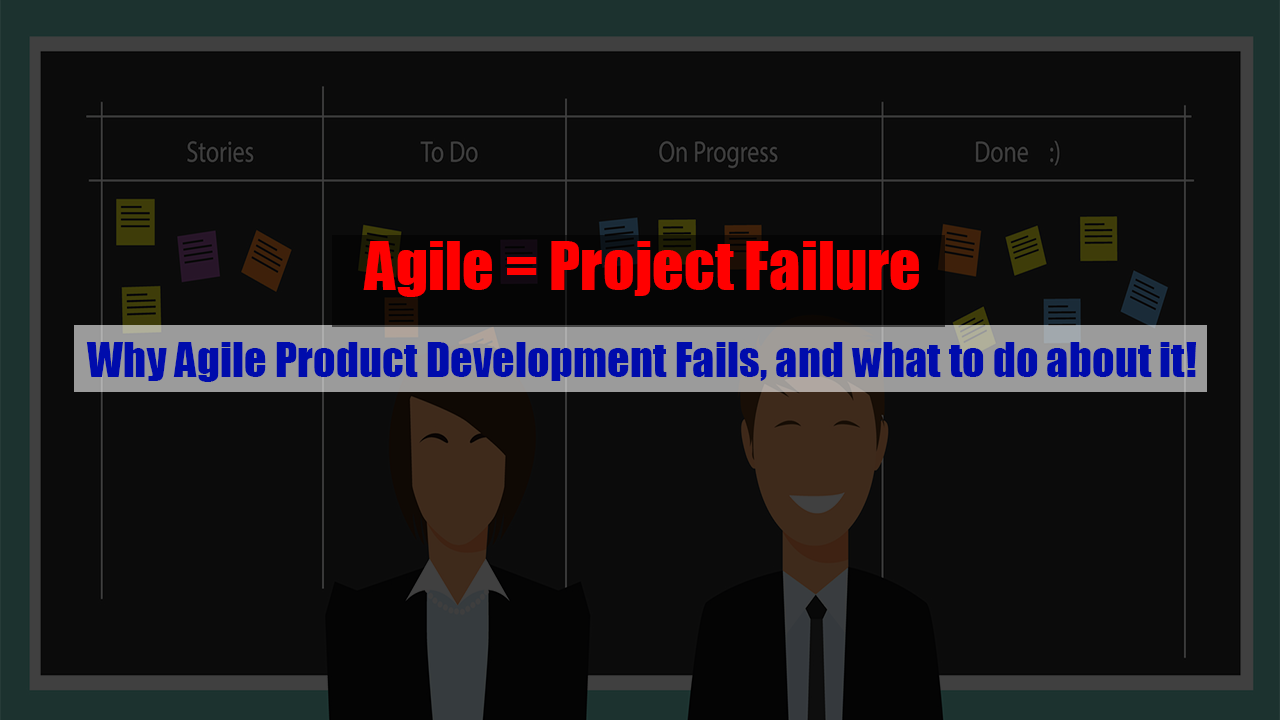Why Agile Product Development Systematically Fails, and what to do about it!

Agile is great for many things, but the way it is taught and practiced today, succeeding in product development is not one of them. I am not talking about why it might fail here and there; I am talking about why it repeatedly fails, again and again. We are observing about 61% failure rate*. In this article, I will not discuss the desirable aspects of Agile. I will discuss why it fails.
What does it mean to succeed in product development?
People are willing to invest a specific amount of resources in your team, expecting to get something specific back, right? If we can deliver that something to them, within the resources, then we can discuss some level of success.
What is that something?
Well, Agile has not understood this question nor the answer. Therefore Agile is failing. Let me explain.
Agile is obsessed with shippable code, minimum viable product, user-stories, burndown charts, Kanban, standup meetings and the like. None of which is what the people investing in the project are expecting to get.
The people investing are expecting that their jobs, their tasks, their products and their services get better, easier, faster, cheaper, more efficient, etc. However, Agile does not prioritize these improvements. It does mention that value is important here and there but has little specific to offer.
Example Case
Let's say a banker wants information faster. Then that is what should be delivered to be successful. We need to determine what type of information under what circumstances and how fast. To determine how fast, we need first to understand how fast the banker gets that information today. Let's say that for the type of information it takes 3 seconds today. Now we know what would be faster, faster than 3 seconds. Next, we need to set a target, typically together with the banker and the development team. Let's say we set the target to 0.5-seconds. I will name it the Banker-Fast.Goal. Now we have determined the improvement the banker expects. Delivering Banker-Fast-Goal, within the resources agreed upon, would be a successful product delivery.
To make the Banker-Fast.Goal happen, everyone needs to exercise extreme focus and prioritization towards reaching the 0.5-second goal. Every decision, every action of all people needs to be directed towards shaving off the seconds. For all decisions, we must ask what will best improve the situation for the banker moving from 3-seconds towards 0.5-seconds. For every prioritization, we must ask which choice will best improve the situation for the banker moving from 3-seconds towards 0.5-seconds. For every task we do, we must challenge it to what degree this task improves the situation for the banker from 3-seconds towards 0.5-seconds. A manager should ask anyone on the team, "the task you are doing right now, how will it improve the situation for the banker from 3-seconds towards 0.5-seconds?"
Measure
Then we must measure reality, and adjust accordingly. The task is 'done' is entirely irrelevant. The only relevant question is; how much faster does the banker get the information?
Agile does not do any of this, so Agile fails*. If you are fiddling around with user-stories and trying to organize and distribute tasks, creating burndown charts and asking about the definition of done, you too will fail. Until you realize this fundamental idea of succeeding in projects, you will keep on delivering code and be experiencing unhappy customers. You might call your project a success, but ask the users and the other stakeholders if they are positively thrilled with the delivery they are getting.
An Invitation
Tom & Kai Gilb have helped numerous companies all over the world to transition from; poor, ineffective ways, to highly profitable intelligent ways, of finding, specifying, developing and delivering customer improvements and thereby succeeding wildly in product development. The body of experience - which can only be hinted at in the space available here is revealed in the workshop: Value First.
How can you learn to succeed in projects?
We have created 3 groundbreaking video tutorials on the subject of What Every Successful Project Manager should know! In the first video tutorial, you will learn about: What your customers want, and what they do not! It is not what you might think! This is different. At this moment the videos are free.
By Kai Gilb
Reference: * I think you know from your own experience that projects do not tend to succeed, but several studies are confirming it, like https://www.scrumalliance.org/community/articles/2016/october/what-we-really-know-about-successful-projects
Overall, Agile projects are three times more likely to succeed than Waterfall projects (39% versus 11%). Large and medium projects show dramatic improvement with Agile. Large projects increase their success rates from 3% to 18% and medium projects from 7% to 27%. Small projects demonstrate smaller gains (44% versus 58%)

